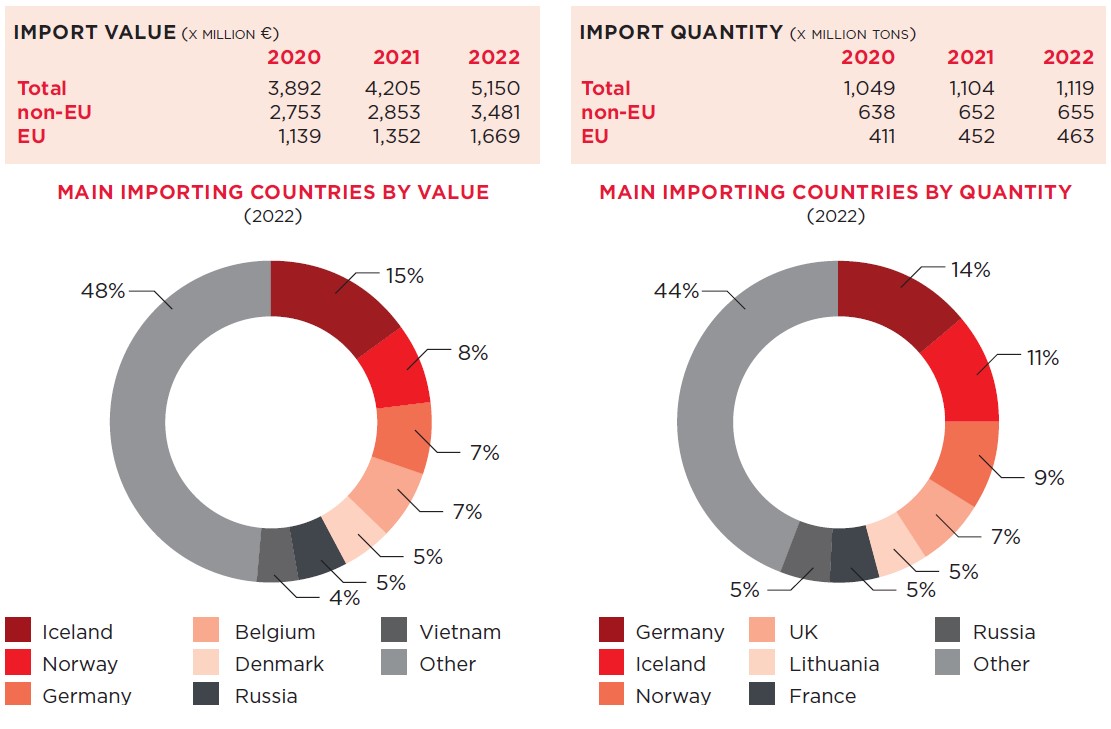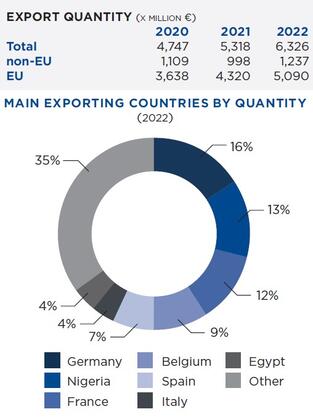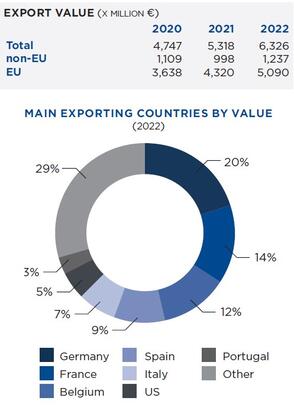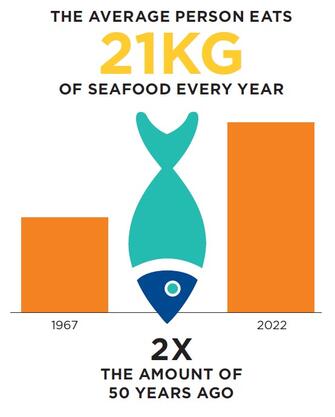Facts & Figures 2022/2023
The Netherlands has a long tradition as a fishing, fish trading and fish processing nation. For centuries Dutch companies have provided a high variety of seafood to Europe and the rest of the world. They have built this history through strong commitment to provide the best possible solution for their customer and through long term relationship. These old traditions are still at the heart of the companies, but incorporated in today’s concept of innovative seafood processing and trade. Maintaining the highest standards for quality and food safety is of the utmost importance. This with respect for nature and people. It comes as no surprise that the Dutch seafood industry is renowned for its high-quality products and the high level of innovations. This brochure gives you an insider’s guide to the facts and figures of the Dutch fish industry, from fishery to exports and imports, from trade to consumption.
AN OUTSTANDING SECTOR WITH A STRONG REPUTATION!
FISHING FLEET
The Dutch marine fishing fleet (almost 600 active vessels) can be divided into industrial maritime fishing (pelagic freezer trawlers), shellfish fishing and cutter fishing.
IMPORTANT TARGET SPECIES
Economically important target species for the Dutch fish industry include sole, plaice, mackerel, brown shrimp, blue mussels and herring. The charts provide more detailed information, such as quotas and volumes of different fish species.
FAMOUS DUTCH HERRING
Every year many consumers look forward to the arrival of the Hollandse Nieuwe. Not only in the Netherlands, but also in neighboring countries. Every year, 25,000 tons of herring are processed into Hollandse Nieuwe. This is 180 million herrings, of which 90 million are exported to Germany, 14 to Belgium and 76 million are consumed in the Netherlands.
TOTAL DUTCH FLAGGED FISHERY
299,000,000 kg (2021, LIVE WEIGHT, EXCLUDING SHELLFISH)
IMPORT
In 2022, the Netherlands imported most of their seafood volume from Germany, Iceland and Norway. Important import products were salmon, cod, small pelagic species and shrimp.
IMPORT QUANTITY (NOT CORRECTED BY WFE) AND VALUE
SOURCE: EUROSTAT, 2023 (EDITED BY WAGENINGEN ECONOMIC RESEARCH)
EXPORT
In terms of exports, the Netherlands plays a prominent role in trading with third countries within the EU. In addition, small pelagic fish species find their way to countries such as Nigeria and Egypt.
In 2022, the main destinations in terms of volume were Germany, Nigeria, France and Belgium. Within the EU the main destinations in terms of volume were Germany, France, Belgium and Spain.
PROCESSING SECTOR
In 2021, the Dutch fish processing industry and fish wholesale had a turnover of around 5,2 billion euro and generated 6,400 full-time jobs (FTE). This is spread across 206 companies in the Netherlands. The fish processing industry is dependent on countries outside the EU for the supply of raw materials. Access to raw materials from outside the EU is therefore of great importance for our sector. The important subsectors of Dutch industry are the round and flat fish industry, importers, shrimps and herring processors, salmon and eel smokers, fish wholesalers and the shellfish sector (Hoekstra et al., 2023 in prep.).
ACCES TO RAW MATERIALS FROM OUTSIDE THE EU IS
OF GREAT IMPORTANCE FOR OUR SECTOR
In the Netherlands the processing and trade sector is not only specialized in species from Dutch fisheries and aquaculture. We process and trade a broad variety of seafood products.
A selection of the products processed in our industry:
- SMALL PELAGIC SPECIES (e.g. MACKEREL, HERRING)
- FLATFISH (e.g. PLAICE, SOLE, TURBOT)
- ATLANTIC SALMON
- ROUNDFISH (e.g. COD, ALASKA, POLLOCK)
- SHRIMP (e.g. BROWN SHRIMP, WHITELEG SHRIMP)
- SHELLFISH (e.g. MUSSELS, OYSTERS, RAZOR CLAMS)
- EEL AND CATFISH
- SEABASS & SEABREAM
SUSTAINABILITY
Sustainable food is defined as food that meets people’s nutritional needs, both now and in the future, while at the same time protecting ecosystems (RIVM, 2023). The EU Common Fisheries Policy obliges the fishing industry in the North Sea to comply with strict measures and regulations in order to maintain sustainable, healthy numbers of fish and in that way guarantee the continued existence of the sector itself (Noordzeeloket, 2023).
FOOD THAT MEETS PEOPLE’S NUTRITIONAL
NEEDS AND PROTECTS ECOSYSTEMS
- (MSC, 2019)
Fish consumption
Dutch people consumed on average 20,7 kg of fishery and aquaculture products per person in 2020 (EUMOFA, 2022). The chart shows the consumption of fish in other European countries and the average of the EU Member States. Fish consumption is expected to increase by a few per cent over the years.
FISH CONSUMPTION IS EXPECTED TO INCREASE
BY A FEW PER CENT OVER THE YEARS
TOTAL CONSUMPTION PER PERSON PER YEAR (INCLUDING OUT-OF-HOME) OF FISHERY AND AQUACULTURE PRODUCTS
| 1 | PORTUGAL | 57.7 |
| 2 | SPAIN | 44.2 |
| 3 | DENMARK | 35.2 |
| 4 | FRANCE | 32.6 |
| 5 | LUXEMBURG | 32.1 |
| 6 | ITALY | 30.0 |
| 7 | SWEDEN | 24.0 |
| 8 | BELGIUM | 23.0 |
| 9 | LATVIA | 22.9 |
| 10 | CYPRUS | 22.8 |
| 15 | THE NETHERLANDS | 20.7 |
| EU-27 | 23.3 |
NATURE
To be able to call a species of fish sustainable, it must fulfill three conditions: the fish stock must be healthy and not overfished, the fishery must not have a significant negative impact on the ecosystem and the fishery must be well managed. The Dutch fish sector is constantly striving for further improvement of its performance. This has resulted in the MSC sustainability certificate for many popular fish species such as herring and the Dutch shrimp now have an MSC quality mark.
- DUTCH MINISTRY OF AGRICULTURE, NATURE AND FOOD QUALITY
Species from Dutch fisheries with MSC certification (Source: MSC, 2023):
- HAND RACKLED COCKLE
- COMMON SHRIMP
- EUROPEAN PLAICE
- SOLE
- ATL. RAZOR CLAM
- HERRING
- BLUE WHITING
- PACIFIC CUPPED OYSTER
- EUROPEAN FLAT OYSTER
AQUACULTURE
Total fisheries and aquaculture production reached a record of 214 million tonnes in 2020, where aquaculture accounted to 122.6 million tonnes (FAO, 2022). Fish production via aquaculture is increasing worldwide. There were 17 landbased aquaculture farms active in the Netherlands in 2022 (NEVEVI, 2023).
THE DUTCH PROCESSING INDUSTRY HAS THE
AMBITION TO MAKE FULL USE OF ALL BY PRODUCTS
All parts of the seafood product should provide added value in the market. For example, flake and mince will be used to create burgers and spreads, fish skins are used to extract collagen for cosmetic use and fish heads and bones are used for soups.
HEALTH
Fish contains many vitamins, minerals, protein, iron and healthy fats, and therefore fits in a healthy diet. Fish contains mainly vitamins A, D and B12, and iodine, selenium and iron. The amount of good fats (omega-3 fatty acids) depends on the fat content of the fish.
These fatty acids are good for the heart and blood vessels and are important for brain development and vision.
- WORLD HEALTH ORGANIZATION








